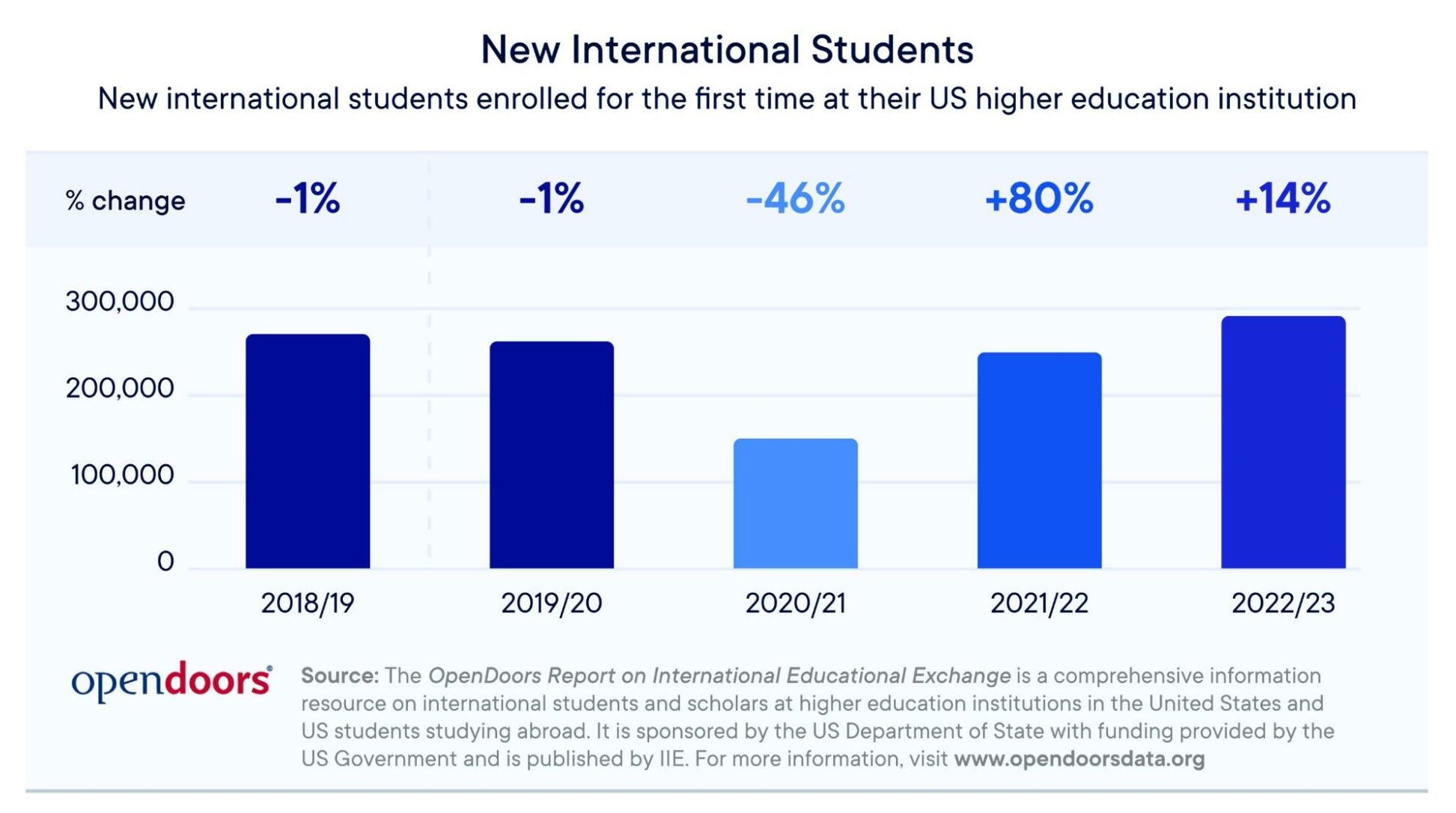In higher ed, the enrollment cliff is defined as a decline in the number of students enrolling in college. The word “cliff” sounds like a sudden sharp decline, but in reality, the enrollment cliff is more of a gradual downturn. Admissions professionals who are faced with enrollment quotas are likely concerned about the enrollment cliff and looking for ways to lessen its effects.
After decades of steady increase, postsecondary school enrollment has been dropping every year since 2010 according to data from the National Center for Education Statistics. All schools are not equally affected by the enrollment cliff. Some schools have already been feeling it for years while others may just be starting to see the effects.
Community colleges, four-year undergraduate institutions, and those in more remote locations could be hit the hardest while elite universities with strong brand recognition will be less impacted. Colleges and universities on the East Coast of the US and in the Midwest may experience the ramifications of the enrollment cliff more than schools in other areas due to more significant declines in population and students leaving the regions for college.
Why is college enrollment declining in the US?
There are several reasons for the decline in college enrollment. First, the birth rate in the US has been declining since the 2008 recession. The CDC reports that in there were 4,247,694 births in 2009 compared to 3,667,758 births in 2022. Children born in 2008 or later will begin to enter college in the next 2-3 years, causing the enrollment cliff to continue through at least 2029.
The COVID-19 pandemic has further exacerbated the enrollment cliff. Decreased immigration and vacillating international enrollment due to the pandemic and increasing anti-immigration sentiments from the US government lead to a decrease in the number of international students enrolling in US colleges from 2016 to 2022. Lastly, due to rising tuition costs, more domestic and international students may have doubts regarding the value of a college degree.
Attracting international students: A key to boosting enrollment
If your institution is experiencing a decline in domestic applicants, focusing on international students can be a strategic way to increase enrollment volume. While the number of U.S. college students is shrinking, the international student population is growing rapidly. In fact, India has climbed to the top of the list with a 35% increase in international students in the US in 2022-2023.
Data from the Institute of International Education shows that the 2022-2023 school year saw an increase in international student enrollment in the US to pre-pandemic levels. Both undergraduate and graduate-level international enrollment rates have risen, but graduate enrollment of international students is growing at a faster rate than undergraduate. This makes international students a key resource in keeping up with enrollment quotas.

Stay competitive: Tips for attracting international students to your institution
Demand for international education continues to rise, with the US remaining a top destination thanks to its many world-class universities. However, countries like Canada, the UK, and Australia are quickly gaining ground as popular choices for international students.
To counter the enrollment cliff and ensure your institution remains a top choice, US colleges and universities must adopt competitive strategies to attract both undergraduate and graduate-level international students. Below, we share actionable tips to help you stand out in the global education landscape.
Tips for attracting undergraduate international students
- Highlight high-quality academic programs and outcomes:
- Showcase the reputation and unique features of your academic programs.
- Emphasize strong employment outcomes for graduates and internship opportunities that prepare students for global careers. Research shows that this a key factor for students considering your college.
- Promote specialized disciplines such as arts programs integrating tech, design, or business, as well as STEM programs with the added benefit of extended OPT work authorization.
- Showcase multicultural experiences and community support
- Highlight the diversity of your student body and faculty to appeal to students seeking inclusive, multicultural experiences.
- Demonstrate how the school fosters community development through clubs, mentoring, and social events—especially important for students living away from their families for the first time.
- Tailor admissions and marketing materials:
- Ensure information is tailored to the unique needs of international students, addressing common challenges and questions about studying in the US.
- Use targeted messaging to emphasize resources for academic, personal, and professional support.
- Connect prospective students with current international students:
- Facilitate opportunities for prospective students to interact with current international students who can share firsthand experiences, answer questions, and offer reassurance.
- Promote programs aligned with global workforce trends:
- STEM programs are particularly appealing due to strong career prospects and the additional two years of OPT work authorization available to international STEM graduates.
- Highlight programs in high-demand fields where US employers face talent shortages, making these pathways more attractive to international students.
By implementing these strategies, your institution can enhance its appeal to undergraduate international students and remain competitive in the global education market.
Tips for attracting graduate international students
Did you know there are more international students in the US enrolled at the graduate level than at the undergraduate level? To capture this audience, institutions must focus on what matters most to prospective graduate students: career outcomes.
A report by Interstride and NAGAP found that 58% of international graduate students said a better understanding of career outcomes would have influenced their choice of institution. To address this, institutions should emphasize employment data that showcases the value of their graduate programs. Key outcomes to highlight include:
- Percentage of graduates with full-time job offers at the time of graduation.
- Percentage of international students with CPT and OPT authorization who secure internships or employment.
- Percentage of international alumni with H-1B or green card sponsorships, showcasing pathways for long-term employment in the US.
- Average alumni salaries, demonstrating the return on investment of your degree programs.
By emphasizing these outcomes, institutions can help prospective students see the long-term value of their education, even when faced with the high cost of tuition.
Additionally, institutions should highlight the presence of international faculty and staff. This sends a strong message that the university values diverse perspectives and creates an inclusive environment, which is particularly important for graduate-level international students.
With a strategic focus on career outcomes and diversity, institutions can better attract and support graduate international students.
Creative strategies for combating the enrollment cliff
Addressing the enrollment cliff isn’t just about attracting more international students—it’s also about retaining them throughout their entire academic journey. High student retention ensures steady revenue for your institution while reducing the impact of enrollment declines. Retention challenges, such as students leaving school for the workforce, dropping out, or transferring to other institutions, can amplify the effects of the enrollment cliff.
To make international students a key part of your overall enrollment management strategy, consider these creative retention strategies:
- Prioritize support for international students: Offer comprehensive support systems that address academic, cultural, and personal challenges. Programs like mentorship initiatives, career advising tailored to international students, and community-building events can foster a sense of belonging and improve retention.
- Streamline the transition to campus life: Ensure international students feel prepared and supported when they arrive. Orientation programs and ongoing resources that address visa compliance, housing, and financial planning can help students navigate their new environment with confidence.
- Expand distance education thoughtfully: While some institutions are combating the enrollment cliff by offering more online courses, keep in mind that international students are limited in how many online classes they can take each semester due to visa restrictions. Ensure your distance education strategy includes in-person or hybrid options that comply with these regulations.
- Enhance career pathways: Help international students see the long-term value of staying enrolled by emphasizing career outcomes, such as internships, CPT/OPT opportunities, and alumni success stories. Highlight programs that prepare students for competitive job markets or advanced studies.
By integrating these retention-focused strategies into your enrollment management approach, you can build a sustainable and resilient plan for combating the enrollment cliff while supporting your international student community.
Overcome the college enrollment cliff
Declining enrollment can be a challenge for admissions professionals, but with the right strategies, the enrollment cliff can be effectively addressed. Partnering with Interstride for Admissions equips your institution to support international students at every stage—from admissions to graduation and beyond.
Features like instant communication tools and connections to current students allow prospects to ask questions about academics, student life, and campus culture, creating a personalized and engaging experience.
By leveraging Interstride, your institution can stand out to international students, fostering trust and interest while building a strong foundation for enrollment success.

